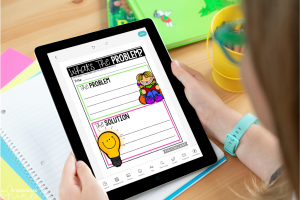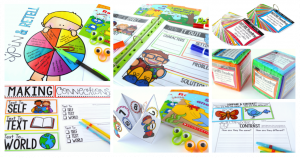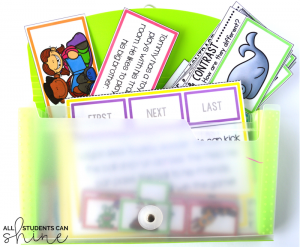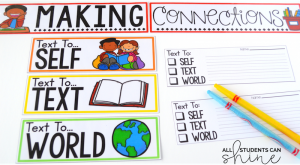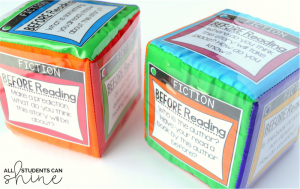Ready for simple ways to increase reading comprehension in your classroom without a ton of planning and prep? Better yet, are you looking for digital resources you can use when students are working in a virtual or socially distanced environment? This post offers up my favorite go-tos to boost proficiency and engagement during your reading instruction. Keep reading for the details and some time saving virtual and printable resources.
Graphic Organizers
Graphic organizers can be a teacher’s (and student’s!) best friend when it comes to organizing thinking, building comprehension and simplifying learning and teacher prep. Students help build and apply writing skills when responding to reading. Graphic organizers are a great way to visually assess where your students are and find out what they need to become proficient readers.
What are Graphic Organizers?
They’re basically a visual way to organize and show thinking when it comes to reading and writing skills. I love how they increase engagement and give students a structure for showing understanding. Graphic organizers build independence with students because there’s a visual component to guide what they should be doing.
You can use them for:
- Guiding thinking about story elements
- Identifying and examining relationships
- Structuring small group and literature circles
- A visual assessment of student comprehension
I have a Graphic Organizer Resource in my TPT store with engaging activities to help your students with comprehension skills. They’re designed for grades K-1, but they are also appropriate for 2nd graders. It’s great for those older kiddos who need practice with skills they’ve been taught previously but haven’t quite mastered.
You be the teacher
Visualize the cover
Story characters
Make a prediction
Story sequencing
Write a summary (3)
Making connections
Problem/Solution
Cause & effect
Story map
Important information
Making inferences
I know all about (2)
Important facts
New vocabulary
You can model how to use the graphic organizers with whatever skill you are teaching. Then students have the opportunity to practice with different texts or parts of stories. You can assign students their own organizer to complete virtually or printed versions independently.
To use them virtually, you can send them via email, use AirDrop (if using iPads), or share with your classroom using Google Classroom, Microsoft OneDrive, or Dropbox. If you’re interested in the printable version, they’re in the guided reading resource discussed in the next section.
Hands-On Games
Hands-on games are meaningful, engaging, and powerful learning tools for increasing reading comprehension. Giving students meaningful experiences to connect with the strategies they’re learning is the driving force that encourages them to stay engaged.
Hands-on activities can also help you with classroom management and assessment by creating collaborative learning opportunities that encourage kids to cooperatively learn together in small groups.
Using hands-on games to target specific comprehension strategies
I have a set of Guided Reading Games that you can print and laminate so kids can practice these activities over and over again.
Some of the activities included are:
Story Sequencing
Students read a short story on one card. They have 3 picture cards with each story that show different parts of the story. Children put the pictures in order showing what happens First, Next, and Last. You can use clips or velcro for students to adhere the ordered parts of the story to their corresponding place on each story card. These activities can be done in a pocket chart or at a desk/table.
Making Connections
This activity can be done in a pocket chart as a whole class to introduce a text or concept, or students can use it as a center or small guided reading group. Start with three laminated cards that read text to self, text to text, and text to world. Students fill out their own card and place it under the correct category showing the connections they’ve made within a text.
Before and After Questioning
This is an awesome activity to use during small groups to check for different comprehension skills. There are three sets of cards for both fiction and non fiction texts. There is a set of Before Reading, During Reading, And After Reading questions to gauge understanding of concepts like making predictions, discussing main ideas and story elements, and reflecting on reading. I like to put these sets on binder rings to keep track of them or in pocket dice to make a game of it.
Just a reminder: The resource above also includes the printable versions of the graphic organizers I talked about in the first section.
Teachers deserve quality activities to promote reading comprehension in their classrooms without having to break the bank or reinvent the wheel. I hope you get some major value from these resources. Make sure to reach out on Instagram or Facebook to keep the conversation going about how I can help you with simple and effective resources from my TPT store.



